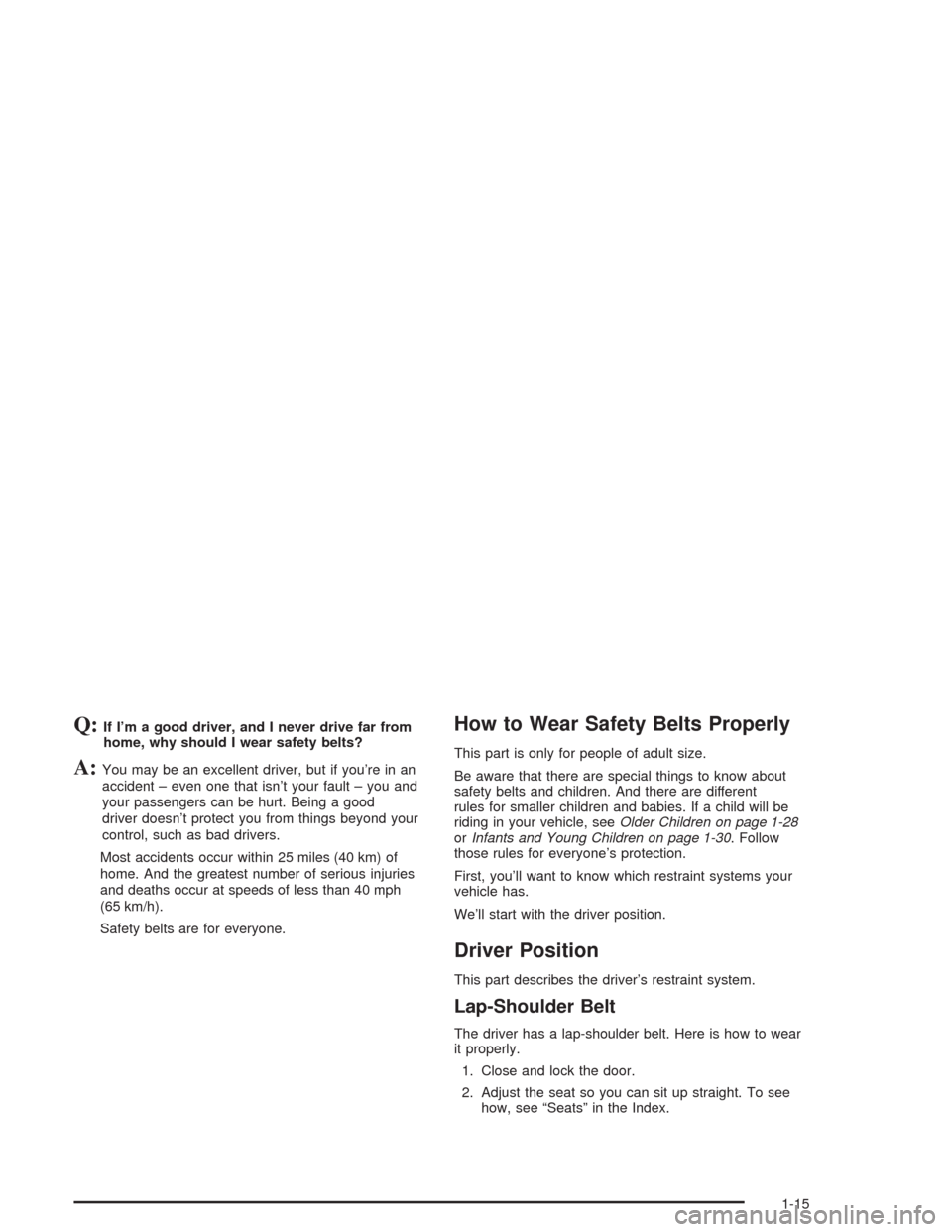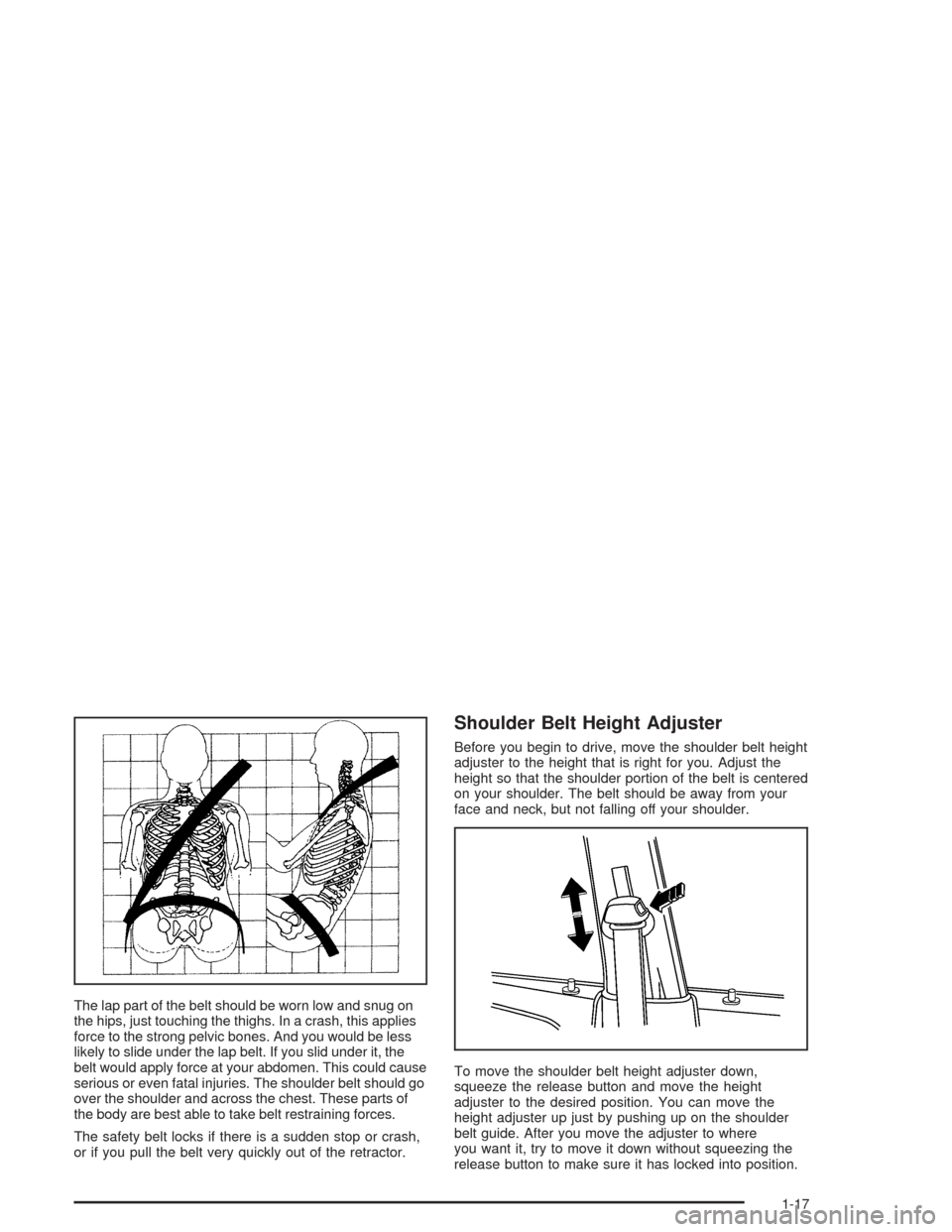Page 7 of 334

Front Seats......................................................1-2
Manual Seats................................................1-2
Driver Seat Height Adjuster..............................1-3
Reclining Seatbacks........................................1-3
Head Restraints.............................................1-5
Rear Seats.......................................................1-6
Rear Seat Operation (Hatchback).....................1-6
Rear Seat Operation (Sedan)...........................1-8
Safety Belts...................................................1-10
Safety Belts: They Are for Everyone................1-10
Questions and Answers About Safety Belts......1-14
How to Wear Safety Belts Properly.................1-15
Driver Position..............................................1-15
Safety Belt Use During Pregnancy..................1-22
Right Front Passenger Position.......................1-23
Rear Seat Passengers..................................1-23
Center Rear Passenger Position.....................1-26
Safety Belt Pretensioners...............................1-27
Child Restraints.............................................1-28
Older Children..............................................1-28
Infants and Young Children............................1-30
Child Restraint Systems.................................1-34
Where to Put the Restraint.............................1-37Top Strap....................................................1-38
Top Strap Anchor Location.............................1-40
Lower Anchorages and Top Tethers for
Children (LATCH System)...........................1-41
Securing a Child Restraint Designed for
the LATCH System....................................1-44
Securing a Child Restraint in a
Rear Seat Position....................................1-44
Securing a Child Restraint in the
Right Front Seat Position............................1-46
Air Bag Systems............................................1-50
Where Are the Air Bags?...............................1-53
When Should an Air Bag Inflate?....................1-55
What Makes an Air Bag Inflate?.....................1-55
How Does an Air Bag Restrain?.....................1-56
What Will You See After an
Air Bag Inflates?.......................................1-56
Servicing Your Air Bag-Equipped Vehicle.........1-58
Restraint System Check..................................1-58
Checking Your Restraint Systems...................1-58
Replacing Restraint System Parts
After a Crash............................................1-59
Section 1 Seats and Restraint Systems
1-1
Page 10 of 334
But do not have a seatback reclined if your vehicle is
moving.
{CAUTION:
Sitting in a reclined position when your vehicle
is in motion can be dangerous. Even if you
buckle up, your safety belts can’t do their job
when you’re reclined like this.
The shoulder belt can’t do its job because it
won’t be against your body. Instead, it will be
in front of you. In a crash you could go into it,
receiving neck or other injuries.
The lap belt can’t do its job either. In a crash
the belt could go up over your abdomen.
The belt forces would be there, not at your
pelvic bones. This could cause serious internal
injuries.
For proper protection when the vehicle is in
motion, have the seatback upright. Then sit
well back in the seat and wear your safety belt
properly.
1-4
Page 11 of 334
Head Restraints
Adjust your head restraint so that the top of the restraint
is closest to the top of your head. This position reduces
the chances of a neck injury in a crash.
Pull up the head restraint in order to adjust the position
upward.Push in the release button and press down on the head
restraint in order to adjust the position downward.
To remove the head restraint, pull the head restraint all
the way up. Then push in the release button and lift
the head restraint from the guide sleeve.
Replace the head restraint and reset it in the original
position before driving.
Your vehicle may have adjustable rear seat head
restraints. Push in the release button and move the
head restraint to the desired position.
1-5
Page 14 of 334
To return the seatback to the upright position, do the
following:
1. Remove the safety belts and buckles from the
storage area.
2. Unclip the hook from the head restraint of the
front seat.
3. Push the rear seat cushion downward to its original
position until it latches securely.
4. Lift up the seatback and push it to its original
position. Ensure that the safety belts are not twisted
or caught under the seatback.
5. Push down firmly on the top of the seatback until it
latches securely in the fully upright position.
6. Place the rear safety belts and buckles in their
original position between the rear seatback and
the seat cushion.Rear Seat Operation (Sedan)
Folding the Seatback
The rear seatbacks can be folded down to increase
cargo space.
To fold down the seatback, do the following:
1. Pull up the release knob located on top of the rear
seatback.
2. Fold the rear seatback forward and down.
1-8
Page 15 of 334
{CAUTION:
If the seatback isn’t locked, it could move
forward in a sudden stop or crash. That could
cause injury to the person sitting there. Always
press rearward on the seatback to be sure it is
locked.
{CAUTION:
A safety belt that is improperly routed, not
properly attached, or twisted won’t provide
the protection needed in a crash. The person
wearing the belt could be seriously injured.
After raising the rear seatback, always check
to be sure that the safety belts are properly
routed and attached, and are not twisted.To return the seatback to the upright position, do the
following:
1. Lift up the seatback and push it to its original
position. Ensure that the safety belts are not twisted
or caught under the seatback.
2. Push down firmly on the top of the seatback until it
latches securely in the fully upright position.
1-9
Page 21 of 334

Q:If I’m a good driver, and I never drive far from
home, why should I wear safety belts?
A:You may be an excellent driver, but if you’re in an
accident – even one that isn’t your fault – you and
your passengers can be hurt. Being a good
driver doesn’t protect you from things beyond your
control, such as bad drivers.
Most accidents occur within 25 miles (40 km) of
home. And the greatest number of serious injuries
and deaths occur at speeds of less than 40 mph
(65 km/h).
Safety belts are for everyone.
How to Wear Safety Belts Properly
This part is only for people of adult size.
Be aware that there are special things to know about
safety belts and children. And there are different
rules for smaller children and babies. If a child will be
riding in your vehicle, seeOlder Children on page 1-28
orInfants and Young Children on page 1-30. Follow
those rules for everyone’s protection.
First, you’ll want to know which restraint systems your
vehicle has.
We’ll start with the driver position.
Driver Position
This part describes the driver’s restraint system.
Lap-Shoulder Belt
The driver has a lap-shoulder belt. Here is how to wear
it properly.
1. Close and lock the door.
2. Adjust the seat so you can sit up straight. To see
how, see “Seats” in the Index.
1-15
Page 22 of 334
3. Pick up the latch plate and pull the belt across you.
Do not let it get twisted.
The shoulder belt may lock if you pull the belt
across you very quickly. If this happens, let the belt
go back slightly to unlock it. Then pull the belt
across you more slowly.4. Push the latch plate into the buckle until it clicks.
Pull up on the latch plate to make sure it is secure.
Make sure the release button on the buckle is
positioned so you would be able to unbuckle the
safety belt quickly if you ever had to.
5. To make the lap part tight, pull down on the buckle
end of the belt as you pull up on the shoulder belt.
1-16
Page 23 of 334

The lap part of the belt should be worn low and snug on
the hips, just touching the thighs. In a crash, this applies
force to the strong pelvic bones. And you would be less
likely to slide under the lap belt. If you slid under it, the
belt would apply force at your abdomen. This could cause
serious or even fatal injuries. The shoulder belt should go
over the shoulder and across the chest. These parts of
the body are best able to take belt restraining forces.
The safety belt locks if there is a sudden stop or crash,
or if you pull the belt very quickly out of the retractor.
Shoulder Belt Height Adjuster
Before you begin to drive, move the shoulder belt height
adjuster to the height that is right for you. Adjust the
height so that the shoulder portion of the belt is centered
on your shoulder. The belt should be away from your
face and neck, but not falling off your shoulder.
To move the shoulder belt height adjuster down,
squeeze the release button and move the height
adjuster to the desired position. You can move the
height adjuster up just by pushing up on the shoulder
belt guide. After you move the adjuster to where
you want it, try to move it down without squeezing the
release button to make sure it has locked into position.
1-17